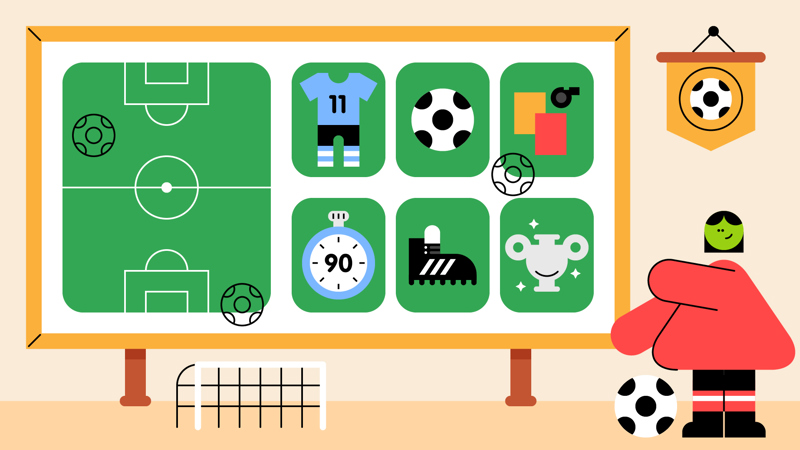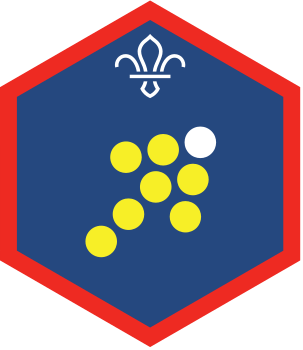
Super skills audit
You’ll need
- Pens or pencils
- A4 paper
- Sticky tack
Before you begin
- You’ll probably need to run this activity across two sessions. ‘Find your super skill’ and ‘get into groups’ in the first session, then ‘Share your super skill’ next time you meet (or another time, if you’ve already got plans).
- It’s likely that you’ll need some extra equipment for ‘Share your super skill’ – it’ll depend on the skills people choose.
Find your super skill
- The person leading the activity should give everyone a piece of paper and a pen or pencil. Everyone should find a space and make themselves comfortable.
- Everyone should think of a football club’s badge. What shape is it? The person leading the activity should share some examples of team badges to get everyone inspired.
- Everyone should choose a shape for the outline of their badge. They should keep it simple – think triangles, squares, or shield shapes. They should draw their outline on the paper – it’s best to make it nice and big.
- Everyone should draw a line through their badge from top to bottom to divide it in half.
- Everyone should think about a super skill they have. It’s helpful to be specific – rather than ‘football’, for example, people could think about keepy-uppies, catching like a goalkeeper, or a special move like the Cruyff turn.
Everyone has different skills – people could choose a skill related to a favourite Activity Badge, like photography or cooking, or something else entirely!
- Everyone should draw something that represents their super skill in the left half of their badge. It doesn’t need to be perfect!
- On the other half of their badge, everyone should draw something that represents a super skill they’d like to develop.
- Everyone should use sticky tack to display their designs on a wall. If anyone’s put similar skills on the right of their badges, stick their badges next to each other.
Space them out evenly around the space, as people will need to be able to stand by different badges.
Get into groups
- Everyone should look at the sketches on the right half of the badges and find the skills everyone would like to learn. They should stand by something they’re skilled in and would be happy to teach someone else.
- The person leading the activity should help everyone figure out their ‘super skill sharer pairs’. They should find the creator of each badge and write their name down with the name of the person standing next to the badge. People may have to be flexible and change their ideas a bit for this to work, for example, choosing another skill if no one’s able to share the skill they chose.
You could have a group or get into pairs, for example, two people could take it in turns to share a skill. If one badge is really popular, you may need to divide it up – generally, groups shouldn’t be bigger than four people.
- Everyone should now be in two pairs or groups – one where they’re learning a skill and one where they’re sharing a skill. The person leading the activity should split everyone in half. One group should share first and learn second, the others should learn first and share second.
It’s probably a good idea to note down who’s in each group, just in case people don’t remember for the next session.
- Everyone should plan exactly how they’ll share their skill and what equipment they’ll need. They should try to come up with a plan to share their skill in between 20 and 30 minutes, including time for the learner to practise their new skill.
- Once everyone’s got a plan, they should check it with an adult. Together, they should decide whether people need to bring any equipment from home or whether everything they need is already in the meeting place.
- The person leading the activity should take down the super skill badges and put them away somewhere safe.
Share your super skill
- Everyone should gather together with any equipment they need to share their skill.
- The people who are sharing first should set up any equipment they need.
- The people who are learning first should join their skill sharer.
- The person leading the activity should start a timer, and everyone should enjoy teaching or learning the super skill.
It’s best if any adults move around, offering support where it’s needed and making sure everyone stays safe.
- Everyone should swap roles and repeat steps two to four – the new skill sharers should set up their equipment, then it’s their turn to shine!
- Once everyone’s finished sharing and learning, they should collect their super skill badge and gather together to reflect.
Reflection
Everyone should look at the super skill badges. This activity needed them to be a great leader and it also gave them the chance to try new things.
While people were sharing their super skill, they used lots of different leadership skills. Can anyone think of an example? People may have examples of how they encouraged others, listened to what they found tricky, or helped everyone to practise for as long as it took without getting impatient! What was the most challenging thing about being a leader? How did it feel to pass on knowledge and experience to someone else?
Everyone’s super skill badge also had a picture of something they’d like to get better at. Did anyone try anything new in this activity? Did people find it easy to be great at their new skill right away? It often takes time and practise to be great at something, so it’s OK if trying something new means making mistakes. What did people learn or achieve?
Safety
All activities must be safely managed. You must complete a thorough risk assessment and take appropriate steps to reduce risk. Use the safety checklist to help you plan and risk assess your activity. Always get approval for the activity, and have suitable supervision and an InTouch process.
It’s OK if people want to write alongside (or label) the drawings on their super skill badge.
- If people only feel comfortable sharing their skill with one or two others, that’s OK.
- Help people adapt their skill and teaching if they need to make it accessible for everyone.
All Scout activities should be inclusive and accessible.
People could take their super skills together to help each other tackle Activity Badges as a team.
This activity is a great chance for young people to take the lead and plan their own activities. The adults are there to offer support, but the young people should take ownership of their skill sharing session.
